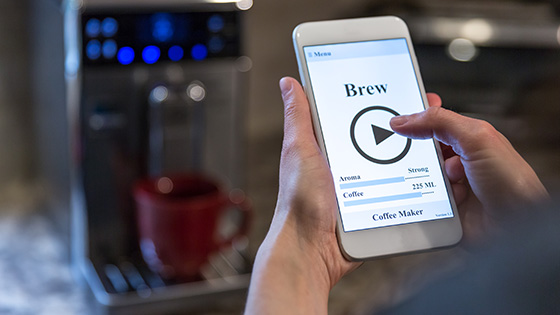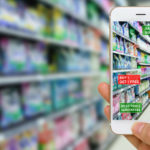
A Food Marketer’s Guide To Programmatic Media
Competition within the media space has always been fierce. But, more than ever, things are heating up within the food industry as new technology, innovation, and start-ups challenge the status quo. Across all sectors of industry, authenticity, customization, and speed continue to be the elements required to “win”. So, when it comes to marketing your food brand, programmatic media buying presents opportunities to promptly connect to the right people at the right time. But you’ll also want to make note of some of its potential hurdles.
An estimated 257 million Americans access the internet on a monthly basis. Increased digital advertising and spending across all mediums has resulted as online usage continues to grow YOY. And, as we enter into the Internet of Things (IOT) era, where consumers are spending more time online via new connected devices, this trend is only expected to steepen. For example, in 2016 we saw record revenue for digital display advertising spend at $72.5B. This figure rose steadily in 2017 and is showing no signs of slowing down in 2018.

The digital advertising space is planned and purchased in many ways, one being programmatically. At the close of 2017, the programmatic digital display advertising spend was projected to reach $32.56B according to eMarketer. By 2019, the upward trend is projected to continue as an estimated $45.72B will flow via automated means.
Technology Helps the Programmatic Process and Adds Complexity
Programmatic involves machine learning decisions on both biddable and non-biddable inventory and relies on human input to create parameters for both the buy and sell sides. Purchases are quoted and made on a per impression basis.
While human involvement in the media buying industry is not going away any time soon, advanced technology, such as artificial intelligence, is already being leveraged in the programmatic process. Currently, programmatic advertisements are being placed online for digital display, video, and social. In the past year, they have expanded to television, outdoor, and radio. As data and technology continue to evolve at a rapid pace, programmatic will undoubtedly continue to advance and become more sophisticated at the same pace.
Before your food brand engages with programmatic buying it’s important you’re clear on the brand’s goals and you have specific KPI’s within your budget parameters. To ensure the success of your campaigns, it is important you understand and remain focused on your target audience. There are several ways to target your consumer programmatically:
Demographic audience targeting allows us to deliver a specific ad to a defined audience only, buying and serving ads to this segment by gender, household income, age, education, relationship status or other demographic attributes.
Behavioral audience targeting takes into account what the person does when online, including their visits to specific websites.
Retargeting is associated with ads that follow you across the Web. Let’s say you looked up a recipe including potatoes on one site, and find an ad for Grown in Idaho French fries starts to follow you as you browse.
Geo-targeting method targets geographically and is also customized based on demo, behavioral and specific geographies down to the zip code level, as well as IP addresses.
Cross-Device serves ads to individuals across multiple digital devices, based on usage. You can re-target across devices knowing someone viewed your product on another device.
Contextual is targeting based on editorial relevance. It looks at keywords of a previously viewed website page and then serves an ad relevant to the content.
Transparency, Monitoring, and Tracking = Better ROI
Despite blacklist, white list and pre-bid filters being applied to help with appropriate placement, brand safety concerns are having an impact on programmatic buys. According to ad tracker Media Radar, the number of brands running programmatic ads in 2017 from January through July dropped 2% compared to the same period a year prior. Both Procter & Gamble and Unilever are increasing their presence in high-CPM digital formats after concerns over their brand safety grew earlier this year.
While programmatic has enjoyed YOY growth, as more dollars are diverted from other media to digital, more transparency and standards are being demanded. The Interactive Advertising Bureau (IAB) is stepping in to create standardization in the industry to address advertiser’s concerns and help media buyers better measure and deliver the results their clients expect.
The Future Expands across Media Channels, TV, Radio, Outdoor and More
 Programmatic media buying is spreading within and beyond digital to other communication media channels. It’s available for television and its momentum is expected to grow. Radio and out-of-home media channels, as they become better internet equipped, will also begin offering programmatic advertising space.<
Programmatic media buying is spreading within and beyond digital to other communication media channels. It’s available for television and its momentum is expected to grow. Radio and out-of-home media channels, as they become better internet equipped, will also begin offering programmatic advertising space.<
Programmatic is not only for ads and promoted posts, it is also available for native, influencer marketing. New startups are offering programmatic Snapchat influencer marketing platforms.
In the near future with the “internet of things” such as voice activated devices, cars, and electronics, programmatic buying will undoubtedly enhance food marketing strategies by expanding the current digital and traditional media landscapes. While this offers more precise ways to reach a targeted consumer segment across a variety of lifestyles, the programmatic approach will become another planning, buying, and measurement challenge media buyers will have to quickly master to stay competitive.





